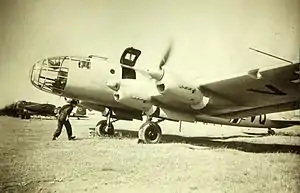Heinkel He 116
The Heinkel He 116 was an extremely long-range mail plane designed to deliver airmail between Germany and Japan. Several examples were built for this role, as well as a small batch to be used in the long-range reconnaissance role.
| He 116 | |
|---|---|
 | |
| An He 116B-0 in service with the Luftwaffe | |
| Role | Mail plane / Reconnaissance aircraft |
| Manufacturer | Heinkel |
| Designer | Siegfried and Walter Günter |
| First flight | 9 December 1936 |
| Primary users | Deutsche Lufthansa Luftwaffe |
| Produced | 1937–1938 |
| Number built | 14 |
Development and design
The design started in response to a 1936 request by Lufthansa, which planned a route over the Pamir Mountains in Afghanistan. This was the primary difficulty in producing an aircraft able to meet the range requirements, because the aircraft would have to lift its large fuel load to 7,600 m (24,900 ft) to clear the mountains. At the time there were simply no engines available with that sort of altitude performance, although Hirth was working on one in the 370 kW (500 hp) class. The Günter brothers proposed to adapt their basic He 70 Blitz airframe to carry four of these engines to provide enough power for the massive fuel load.
The He 116 would use a modified version of the He 70's two-spar elliptical planform, skinned (like the He 70) with plywood. The fuselage was all-new, consisting of a semi-monocoque duralumin body with watertight bulkheads in case the aircraft were forced down over water. The design shared enough construction with the He 70 that the first prototype He 116 V1 was completed in early 1937. The new engines were not ready at this point, so the prototype was instead fitted with the much smaller Hirth HM 508C of 180 kW (240 hp).

Registrations names and designations
- V1 Lübeck
- apparently remained unregistered.
- V2 Schlesien D-JAIE
- operated by Lufthansa.
- V3 Rostock D-ARFD
- (He-116A-03 / He 116R) the third prototype modified for record breaking long-distance flights.
- V4 Hamburg D-ATIO
- (He 116A-02) operated by Lufthansa.
- V5 Nogi J-BAKD
- Delivered on 29 April 1938 to Japan in a six-day flight covering 15,251 km (9,477 mi; 8,235 nmi) in 54 hours 17 minutes of flight time. For use by Manchurian Air Transport on the Tokyo-Hsinking route.
- V6 Tojo J-EAKF
- Delivered on 29 April 1938 to Japan in a six-day flight covering 15,251 km (9,477 mi; 8,235 nmi) in 54 hours 17 minutes of flight time. For use by Manchurian Air Transport on the Tokyo-Hsinking route.
- V7 & V8
- converted to He 116B standard as long-range reconnaissance aircraft.
- V9 to V14
- (He 116B-0) Six un-armed long-range reconnaissance aircraft, relegated to photo-mapping duties.
Variants
- He 116A
- High-speed long-range Mail-plane / courier aircraft, with conventional stepped windscreen: eight aircraft built (V1 to V8)
- He 116B
- V7 and V8 were modified for the long-range reconnaissance role with a fully glazed un-stepped nose similar to the Heinkel He 111, tested during 1938 with generally favourable results. Six additional aircraft based on the V7 pattern were then ordered, designated He 116B-0, although they also received prototype numbers V9 to V14. The B-0 s were intended to operate at extremely long range, outside the range of enemy fighters, and therefore had no defensive armament fitted. All eight (V7 through V14) were issued to reconnaissance units prior to the war, but by that time the idea of a slow-moving unarmed plane providing any useful information seemed unlikely. Instead they were used over German territory providing mapping services.
- He 116R
- V3 was removed from the line to be converted into a record-breaking prototype. The modifications included a larger 75.6 m2 (814 sq ft) wing with a 25 m (82 ft) span, and increased fuel tankage in the fuselage. The 180 kW (240 hp) Hirth HM 508H engines provided a better fuel economy through operation at lower rpm. For take-offs with maximum fuel the He 116R, Rostock, was fitted with four RATO units. On its first record flight attempt one of the rockets tore loose and hit the wing, requiring extensive repairs. After repairs were completed a second attempt was made on 30 June 1938, successfully covering 9,942 km (6,178 mi; 5,368 nmi) unrefueled, at an average speed of 214 km/h (133 mph; 116 kn).
Specifications (He 116A)
Data from German aircraft of the Second World War,[1] Jane's all the World's Aircraft 1938[2]
General characteristics
- Crew: 4
- Capacity: 2,830 kg (6,240 lb) disposable load
- Length: 13.7 m (44 ft 11 in)
- Wingspan: 22 m (72 ft 2 in)
- Height: 3.3 m (10 ft 10 in)
- Wing area: 62.87 m2 (676.7 sq ft)
- Empty weight: 4,050 kg (8,929 lb)
- Gross weight: 7,130 kg (15,719 lb)
- Fuel capacity: 2,650 l (700.1 US gal; 582.9 imp gal)
- Powerplant: 4 × Hirth HM 508C V-8 inverted air-cooled piston engines, 180 kW (240 hp) each
- Propellers: 2-bladed Constant-speed propellers
Performance
- Maximum speed: 325 km/h (202 mph, 175 kn) at sea level; 355 km/h (221 mph; 192 kn) at 5,000 m (16,000 ft)
- Cruise speed: 300 km/h (190 mph, 160 kn) at 5,000 m (16,000 ft)
- Landing speed: 110 km/h (68 mph; 59 kn)
- Range: 4,100 km (2,500 mi, 2,200 nmi)
- Service ceiling: 6,600 m (21,700 ft) service ceiling
- Time to altitude: 1,000 m (3,300 ft) in 3.5 minutes
- Wing loading: 113 kg/m2 (23 lb/sq ft)
- Power/mass: 0.06 hp/lb (0.099 kW/kg)
References
| Wikimedia Commons has media related to Heinkel He 116. |
- Smith, J.R.; Kay, Anthony L. (1972). German aircraft of the Second World War (1st ed.). London: Putnam. pp. 274–276. ISBN 9780370000244.
- Grey, C.G.; Bridgman, Leonard, eds. (1938). Jane's all the World's Aircraft 1938. London: Sampson Low, Marston & company, ltd. p. 155c.